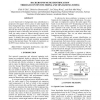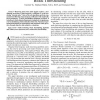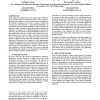277
click to vote
ICA
2012
Springer
13 years 8 months ago
2012
Springer
Abstract. Missing data in corrupted audio recordings poses a challenging problem for audio signal processing. In this paper we present an approach that allows us to estimate missin...
128
Voted
DSP
2011
14 years 4 months ago
2011
We present a technique that efficiently describes nonstationarity by parametrizing spectral peaks in terms of the frequency reassignment operator variation and null-to-null peak b...
136
Voted
TASLP
2010
14 years 7 months ago
2010
We present a scalable medium bit-rate wide-band audio coding technique based on frequency domain linear prediction (FDLP). FDLP is an efficient method for representing the long-ter...
169
Voted
ICASSP
2010
IEEE
14 years 7 months ago
2010
IEEE
A novel framework for background music identification is proposed in this paper. Given a piece of audio signals that mixes background music with speech/noise, we identify the musi...
TIFS
2010
14 years 11 months ago
2010
—This paper addresses a forensic tool used to assess audio authenticity. The proposed method is based on detecting phase discontinuity of the power grid signal; this signal, refe...
98
Voted
TSP
2008
15 years 12 days ago
2008
Abstract--Removing noise from audio signals requires a nondiagonal processing of time-frequency coefficients to avoid producing "musical noise." State of the art algorith...
100
click to vote
ICASSP
2010
IEEE
15 years 22 days ago
2010
IEEE
In this paper, a new type of metric that defines the similarity between musical audio signals is proposed. Based on the spectral flatness criterion, those metrics achieve low co...
100
Voted
ICASSP
2009
IEEE
15 years 4 months ago
2009
IEEE
In this paper we propose a new set of parameters for audio signal analysis and classification. These parameters are regressions computed on the normalized modulation spectrum of h...
102
Voted
MM
1999
ACM
15 years 4 months ago
1999
ACM
A real-time audio segmentation and indexing scheme is presented in this paper. Audio recordings are segmented and classified into basic audio types such as silence, speech, music,...
111
click to vote
ISMIR
2001
Springer
15 years 5 months ago
2001
Springer
In this paper, the problem of processing audio signals is addressed in the context of query-by-humming systems. Since singing is naturally used as input, we aim to develop a front...



